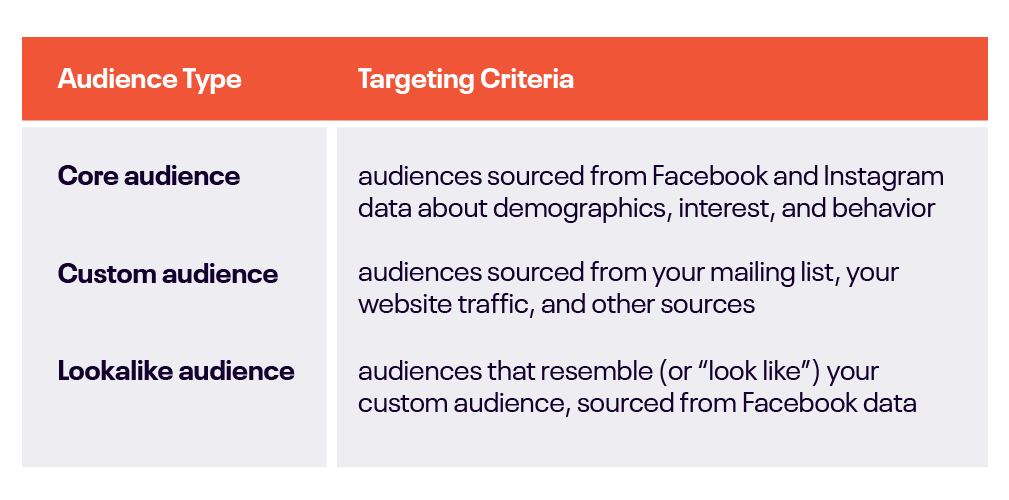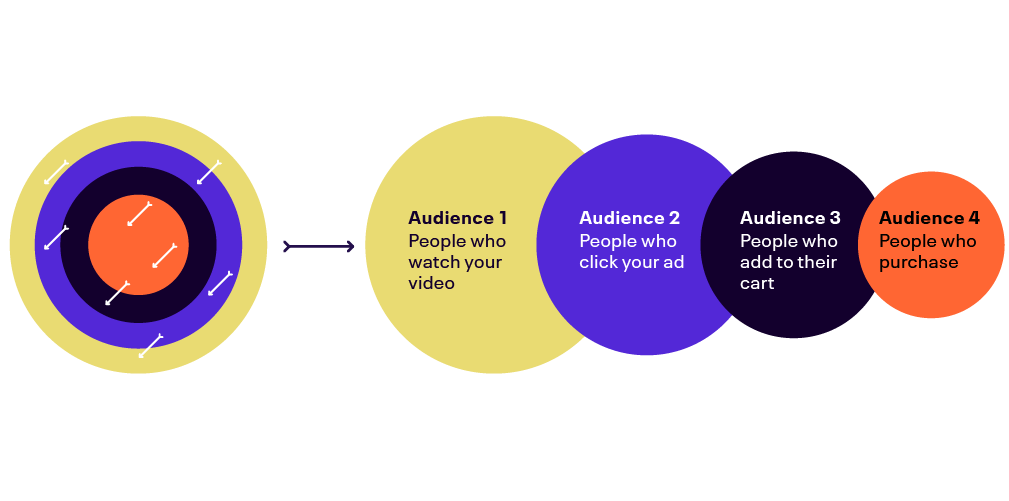A successful event advertising strategy relies on audience targeting. Your targeting may be broad or extremely narrow, depending on your goals (e.g., attract new people, drum up brand awareness, sell out an ultra-intimate event).
If you’ve done any advertising on Facebook, Instagram or Google, you’ve already received a crash course in audience targeting. So whether this is a rundown or a refresh, we’ll use Facebook marketing as an example.
Understand audience types
Facebook and Instagram distill audience targeting into three pools: core audiences, custom audiences, and lookalike audiences. Those audiences are defined by their targeting criteria.

Here’s an example: Rashon is hosting a stitch-and-sip class on Thursday night. He wants to advertise to people who share his enthusiasm for textiles and crafts.
Saved (also known as core) Audience: With Facebook’s interest data, Rashon can target people who expressed interest on Facebook in textiles or crafting.
Custom Audience: With the Facebook pixel installed on his website, Rashon can target people who have visited his website in the past.
Lookalike Audience: Perhaps Rashon’s audiences aren’t engaging like they used to, or he wants to tap a new audience or quickly compare two audiences against each other. With a data source, such as website visitors or previous ad clicks, Rashon can target a new audience of people who have similar characteristics to those who have visited his website or interacted with his ads before. Facebook does the work here. Its algorithm figures out who’d be most likely to click through your campaigns based on interests, interactions (likes, comments, shares on your business account) and prior ad engagement.
All custom audiences are not created equal
How do the different custom audiences stack up? These are the audiences event creators find the most profitable.
- Web Traffic: Individuals who visit your event website or your Eventbrite ticketing page.
- Facebook Events Engagers: Individuals who visit your Facebook event pages and RSVP as ‘Going’ or ‘Interested.’
- Customer List: This audience consists of your mailing list. Oddly enough, your previous buyers and people on your mailing list tend not to be repeat event goers.
- Interest Audiences: True workhorse of Facebook advertising. If you don’t have an audience from the previous three sources, this is your best shot of getting in front of new people.
- Facebook and Instagram Page Engagers: Individuals who’ve liked your Facebook, followed your Instagram page, or engaged with it (e.g., commented or liked your posts).
When you’re advertising your events, it’s important to include different types of audiences in your campaigns, not just interest-based audiences.
Prospecting expands your targeting reach
Forget junior high social studies: We’re not talking about gold mining. Wherever you’re beginning your advertising journey, set aside a budget for audience discovery, also known as prospecting.
Think of your ideal audience (an audience that sees your ads and instantly buys tickets) as the bull’s eye in a game of darts. Throw one dart and your odds of hitting the bullseye are a lot lower than if you throw 100 darts. 
Prospecting is like throwing a handful of educated darts. And though it may seem counterintuitive to spend advertising budget on people who aren’t repeat ticket purchasers, marketing is a long game. Take prospecting into account when you create your advertising budget to leave room for exploration. In other words, buy yourself a bigger pack of darts.
Retargeting is the next step
Once your first ad campaign is underway (high-five!), you can start retargeting. The first step is a temperature check. Have you heard the terms “hot” or “cold lead”? “Hot” leads are audiences with demonstrated interest in your events.
An audience’s temperature is determined by behavior. People who visit only your events page may be cold audiences whereas people who follow you on Eventbrite or subscribe to your mailing list may be warm. Hot audiences have invested their time and resources in your events: They purchased a ticket (or many tickets!).

When you’re producing great events, the longer you advertise, the more people will demonstrate interest in your events. And as these audiences go from “cold” to “hot,” they become less expensive to advertise to.
Once an audience is hot, your paid advertising efforts may decrease. Shift your budget toward converting cold and warm audiences, and rely more on organic marketing to continue retaining and fostering loyalty with the hot ones.